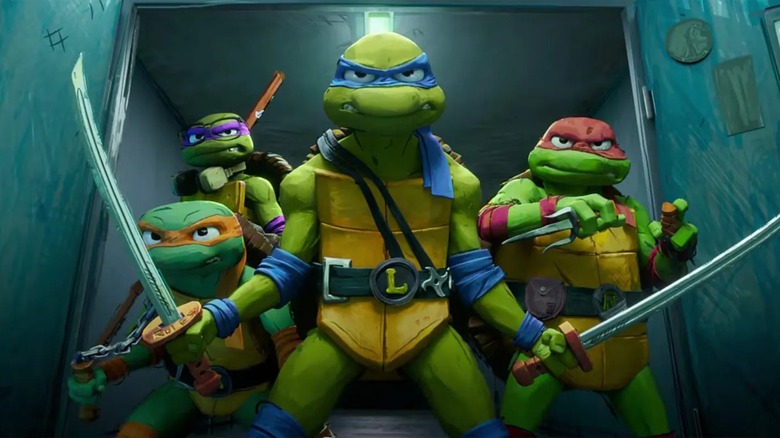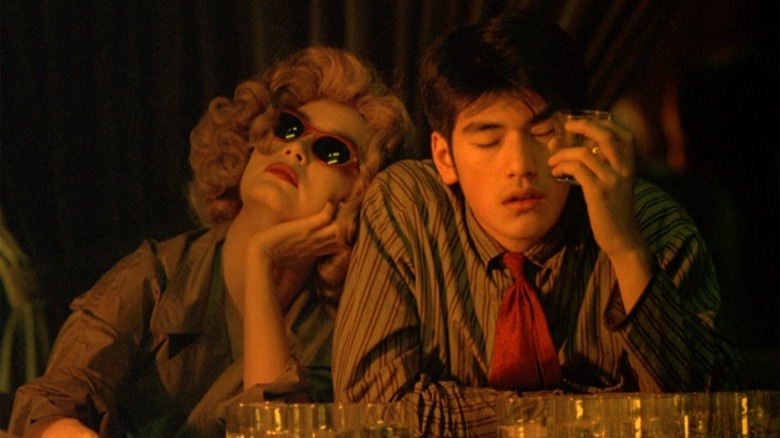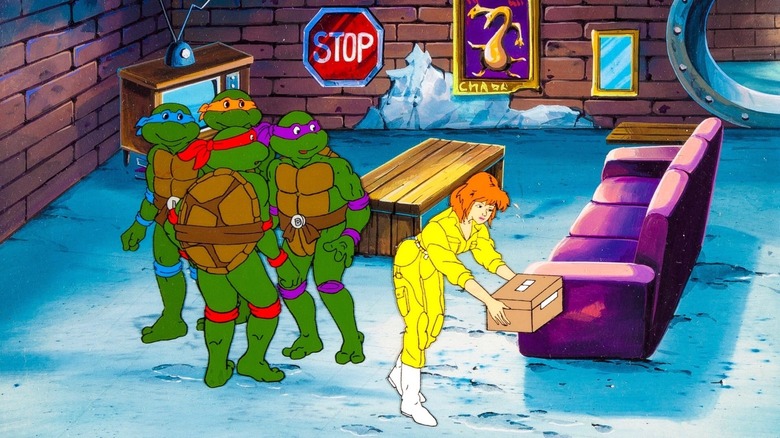How Teenage Mutant Ninja Turtles Cartoons, Toys, And Chungking Express Inspired Mutant Mayhem
The preview for Jeff Rowe's upcoming animated feature "Teenage Mutant Ninja Turtles: Mutant Mayhem," due in theaters on August 2, 2023, displays a wildly stylized animation technique that makes the characters look like living 3D graffiti. The turtles and most of the supporting cast, while realized via CGI, are given stray "sketch lines," blocky body proportions, and painterly textures, allowing them to look like walking neo-Cubist paintings. The quality of the film's writing or themes cannot be determined until audiences and critics have a chance to see the movie, of course, but the visual style can be enjoyed in brief bursts via its advertising.
The Ninja Turtles were invented by Kevin Eastman and Peter Laird back in 1984 as a satirical response to the ultra-serious tone certain superhero comics were taking at the time (notably Frank Miller's work on "Daredevil"). A few years later, the Turtles exploded into the mainstream with video games, toys, and a whimsical 1987 animated TV series. For a generation of children, the animated series became a pop culture bedrock, with its ridiculousness standing as the central pivot point in the franchise. The series, by the way, featured the already-absurd mutant heroes facing off against a martial arts master and an interdimensional fascist who was a disembodied brain in a robot body, not to mention other mutants. A lot of other mutants.
In a recent interview with Variety, "Mutant Mayhem" production designer Yashar Kassai cited the 1987 TV series as the primary inspiration for his film, as well as a perhaps-unexpected source. Kassai noted that Wong Kar-Wai's celebrated 1994 crime diptych "Chungking Express" served as a major influence as well.
Chungking Express
"Chungking Express" caused a notable stir in the indie film scene in 1994, garnering a great deal of critical attention and audience acclaim. It was touted vocally by director Quentin Tarantino, who had just become a darling in the film world thanks to the then-brand-new "Pulp Fiction." Wong's film tells two stories, each one a romance between a cop and a criminal. It was cited as the eighth-best movie of all time in the 2002 Sight & Sound poll.
"Chungking Express" was partially shot by Christopher Doyle, one of the better cinematographers currently working, and he captures light that seems to be hanging in the air or emanating from the hearts of the characters. Everything is shockingly colored and warm, and the characters are all dressed in colorful, wild, stylish outfits. It's easy to see how an animator or production designer like Kassai might draw influence from Doyle's look and Wong's direction. Kassai said in Variety:
"We were also heavily inspired by films like 'Chungking Express.' The Turtles are hiding from humans so it all takes place at night, and these kids have to hide in the shadows because they want to be a part of human society but they feel kind of unsafe when they're around humans because of what their dad has told them about humans. So they cannot be like on a sunlit beach or on a sunny day in, like, Central Park. We spent a lot of time diversifying what New York at nighttime looks like and giving it a variety of different color schemes."
If one sees a lot of reds and garishly-lit alleyways, that would be the Wong influence.
The 1987 animated series
But the primary influence for "Mutant Mayhem," Kassai said, was the 1987 TV series. The playful level of that show's naturally accepted weirdness was their aim. For one, the premise — teenage, mutant, ninja turtles — was presented matter-of-factly, as if that's the most natural thing in the world. When other creatures and aliens appeared, it was an expected outcropping of the world. Because the title characters were teenagers, there was a great deal of immature humor involved. As Kassai said:
"Our Holy Grail of the entire franchise has always been the late '80s cartoon, the original series, and that really wacky toy line that came out during the early '90s [...] We were looking back to the time when sophomoric gross-out humor was the comedic style of the day. So we started there, but then we added the teenage drawing aspect on top of it as a very strong top layer."
It should be noted that the 1987 series and the 1990 toy lines were also a primary influence on the 2016 live-action/animated film "Teenage Mutant Ninja Turtles: Out of the Shadows," a supremely silly and rather entertaining film that featured notable toy references (a van could fling manhole covers as weapons) and weird villains (Krang the disembodied brain was the antagonist). "Mutant Mayhem" will be the seventh feature film to star the Ninja Turtles, and one can only hope it nails the right tone while still finding a place in the hearts of young fans and some of the older ones.


